Easy Apple Galette is essentially a semi-open-faced, freeform round tart with rugged edges that has a spiced and sliced apple filling. There is no blind baking, crimping or cutting needed for this rustic apple tart. Late-season apples are ideal for making this French dessert that pairs well with ice cream or on its own!
One of the first things I learned to make when attending a French dessert class over thirty years ago was a classic galette using pâte brisée as the base. But as I grew as a home chef and visited various parts of France, Switzerland, and Belgium, I was amazed at the different types of pastries, fillings, and methods that encompass the wonderful world of galettes.
Origin of the Apple Galette:
Obviously, galettes originated in medieval France around the 13th or 14th century and are derived from the Norman word ‘gale’ which means ‘flat cake’. Depending on the region and the meal (breakfast, lunch, dinner, or dessert), a galette can be savory or sweet, it can vary from a pancake to a tart, it can be rustic to royal, and it can be made with fruit, vegetables, or even have meats. What began as a simple recipe became a veritable French ocean.
To be candid, when one talks about pastries and cakes, the journey can be traced back to the 18th and 19th century, which I think of as the golden age of the French pâtissier. From éclairs and croissants to the galette, I believe that the French have given the world more techniques and recipes that transform flour, dairy, and heat into mouthwatering creations than anyone else.
But today, I’m going to be talking about the Apple Galette that is so easy to make. This version of the galette is the one that most people are familiar with. It is essentially a semi open-faced, freeform round tart that has a spiced and sliced apple filling. As I’ve simply pinched the overlapping pastry to form a semi-enclosed container, it’s rustic. If you carefully crimp and shape the pastry, it becomes something fancier.
Benefits of apples:
As summer wanes to a cooler autumn, I’ve chosen to use late season apples, which are just bursting with sweetness and form a perfect counterpoint to the pastry. In California, especially in the Bay Area, we are spoilt for choice in terms of apples. Ranging from tart to cloyingly sweet, the choice of apples will certainly alter the taste of the tart.
Apples are naturally sweet as they contain about 11 grams of sugar per 100 grams. They are also a fiber-rich food, and a slice of baked apple can contain 4 to 5 grams of fiber, which is about 17 to 20 percent of recommended daily fiber intake. As a source of health, apples are a great source of vitamins A, B-6, C, and E, as well as thiamin, riboflavin, niacin, and folate. While raw apples are a wonderful source of polyphenols, which are antioxidants, their concentration wanes when apples are cooked.
For this particular recipe, I have chosen the Golden Delicious that I grow in my garden. I used this because it is known for its naturally sweet flavor. I can therefore reduce the added sugar content. If you prefer a soft and sweet pie, then the Golden Delicious is the way to go because you can either choose to peel the skin or keep the skin on and the flesh becomes softer than other varieties. If you prefer the apple slices to hold their shape and like more tart than sweet, try the Braeburn.
Types of French pastry dough:
As I mentioned earlier, I cannot think of any other type of cuisine that creates such a variety of foods based on heating flour and dairy. This recipe uses pâte brisée as the base. Often thought of as the most basic crust, brisée translates to broken or cracked in English. It is the British short crust pastry and the American pie crust. The typical pâte brisée has three parts flour, two parts butter, and one part liquid. Adding sugar reduces gluten formation and adds a lovely crunchy texture to the tart, while also helping the crust retain some moisture. In addition, the sugar also gives the crust a lovely wheat-gold coloring.
While many traditionalist feel that the butter needs to be incorporated by hand (it’s called frissage) because the butter is thoroughly worked into the dough, I find that both the stand mixer or food processor methods and by hand works just as well. Now, I don’t use eggs in this recipe, but if you did, the pastry would now be called pâte à foncer.
Other types of classic French pastry doughs:
- Sucrée: This comes from the French word for sugar – sucre. While it is similar to brisée, the key difference is that you have to cream the butter and sugar together first, and then add the eggs and flour. This makes the dough light and crisp, while also making it strong enough to hold liquids.
- Sablée: This comes from the French word ‘sabler’ which means sandy. Of course, there’s also the origin of the recipe itself from a town in the Loire called Sablée-sur-Sarthe. The one I prefer is the process of making this dough called sablage which involves mixing flour and sugar together, and then mixing in diced, cool butter with ones’ fingertips. The end result is a coarse and sandy dough that can be pressed and baked. I think the use of the fingertips pushes this type of pastry into the “traditionally toughest type of dough to make” category.
My daughter wanted me to use the food processor as I have always been making it by hand, which is the more traditional method. She would some times make the Apple Galette easily with a food processor, and it would taste great even with pears. Both methods seem to yield good results. If you choose to use your hands to make the short crust pastry, then you rub in the fat with a pastry cutter or your fingertips and combine to form a dough with ice cold water. It is that simple.
My family loves this dish when made with pie crust or short crust pastry. I have made almost all of the recipes in this blog several times over the years and have finally decided to go with what tastes and works best for my family. In any case, this Easy Apple Galette is an almost perfect dessert that can be served on its own, with ice-cream, or even a brisk coffee. From my pen to your table, bon appétit!
Ingredients:
- Apples: You could choose from Braeburn, Honey Crisp, Granny Smith, Pink Lady, Fuji or Gala. I have used homegrown Golden Delicious. This is a rustic tart that was made in the French farmhouses, and some times the recipes depended upon the cook. The apples were generally not sliced very thinly but roughly chopped or sliced. I have precooked the apples slices to prevent the crust from becoming soggy. If you choose to add the slices directly on the crust, then sprinkle some flour or semolina to the slices to absorb the moisture.
- Butter and all-purpose flour: I used the short crust pastry dough for the base. You could choose to use any of the four types of crusts. European butter is preferred due to its high fat content that has enriched the Apple Galette.
- Lemon juice: Lemon or lime juice maybe used for both its flavor and to prevent the apples from getting discolored.
- Granulated sugar: Caster or granulated sugar in the apple filling is essential for a slightly sweet taste. From my past research when I first started making this tart, sugar is usually not sprinkled on the crust. I have not added any sugar to the crust since my homegrown apples are sweet, but feel free to do so. You could sprinkle demerara or turbinado sugar if you like. I did not brush the crust with egg wash or cream because I wanted to give the crust a more rustic look and feel.
- Nutmeg: Grated nutmeg is the perfect pairing for the Apple Galette in my opinion. In most places here in the U.S, cinnamon is widely used in pastries.
Frequently Asked Questions:
1. What is the difference between a galette and a pie?
A galette is an semi-open-faced tart with a free form while the pie has a base crust and a top crust. A galette basically has one layer of pie that is encases a filling.
2. Can the dough be frozen?
The short crust pastry or pâte brisée can be frozen for at least three months using a plastic wrap. It can be refrigerated for several days in an airtight container or plastic wrap. Frozen unbaked Apple Galette (tightly wrapped) can be baked straight from the freezer on a lined baking tray. If you would like to use the dough from the freezer, defrost it in your refrigerator overnight and then roll and bake.
3. Can I make a hand-held version of the galette?
Yes, in fact, I have made hand-held galettes for my kids birthday parties. It does not take much time to make them as I would just roll small discs of the pastry dough. There is no crimping or cutting for any lattice work. I would place the cooked apple slices in the center and fold the edges over the fruit. Kids have loved this Easy Apple Galette with ice cream on the side or à la mode.
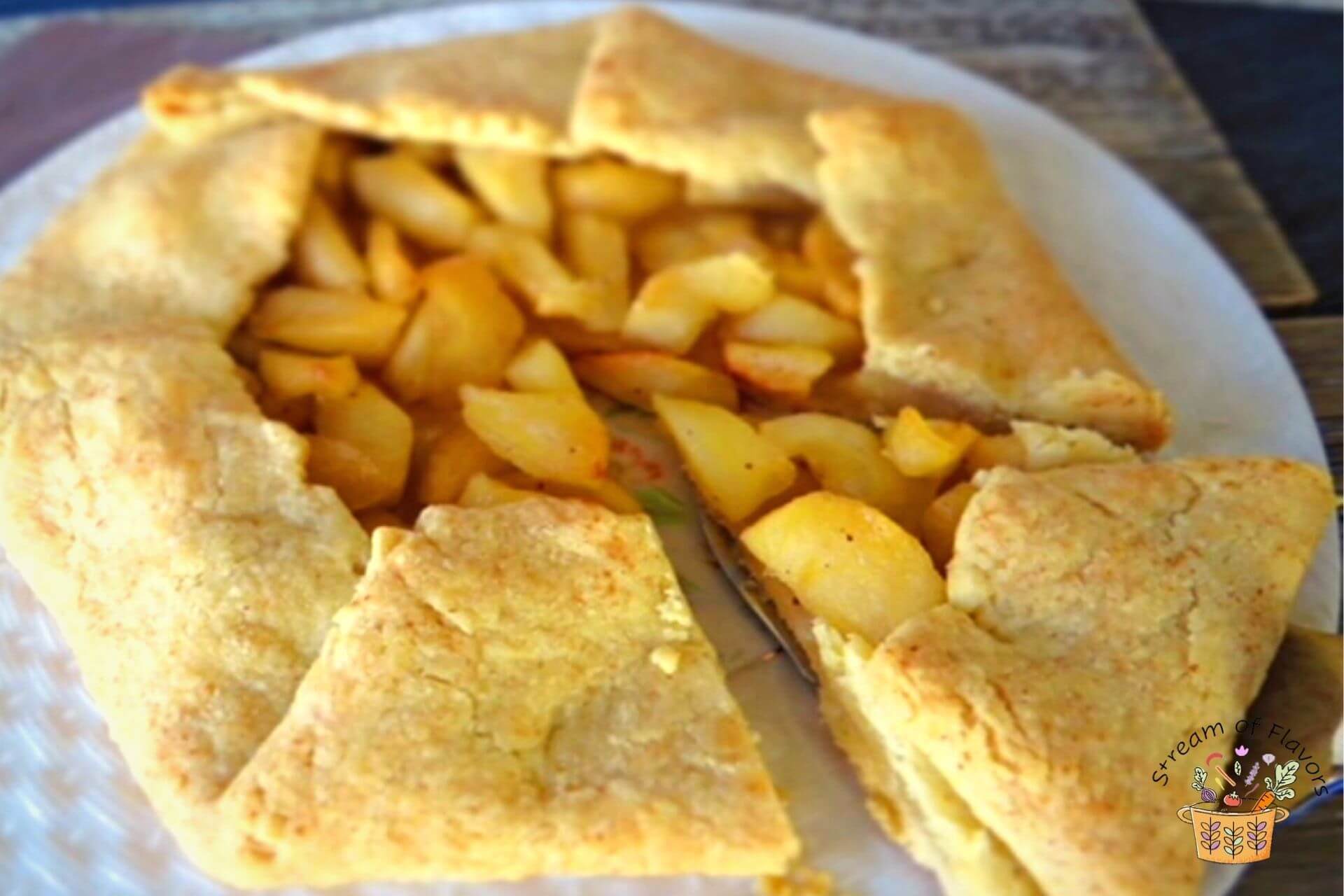
How to make my Easy Apple Galette:
- How to make the crust:
- How to make the apple filling:
- How to assemble the Apple Galette:
- How to make the crust:
- In a food processor, place the flour, salt and butter cut into cubes
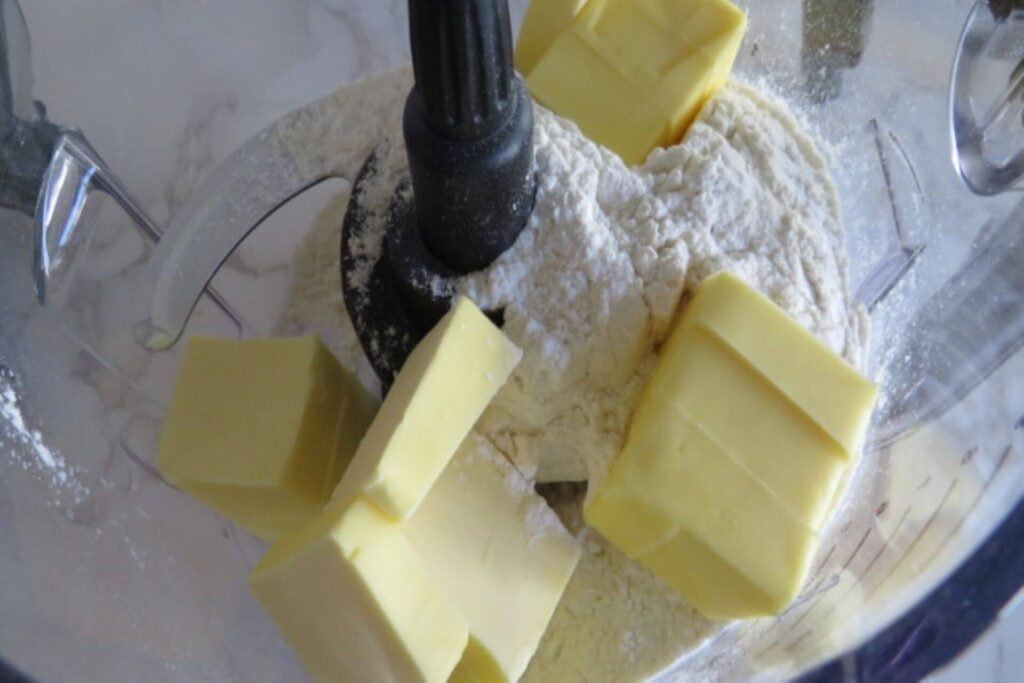
- Turn on the food processor and give it a quick spin using the dough button for just a few seconds. The butter will be “rubbed” into the flour and will look like bread crumbs.
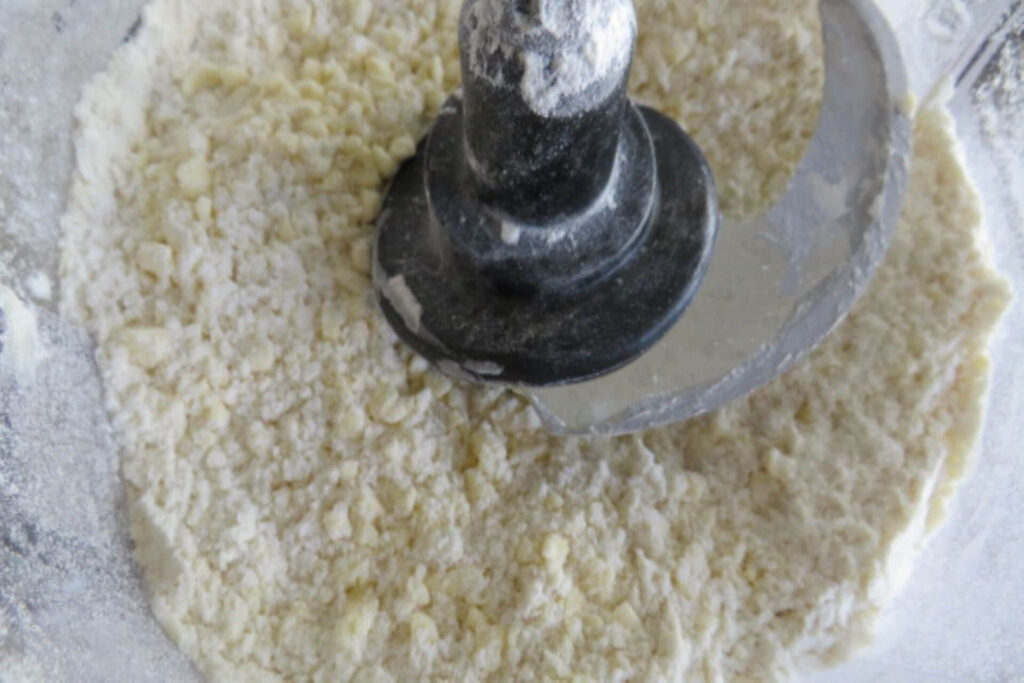
- Now, add the ice cold water and spin until combined. Empty the contents of the jar on a floured surface and knead into a disc. Refrigerate the disc wrapped in cling film for 15 minutes.
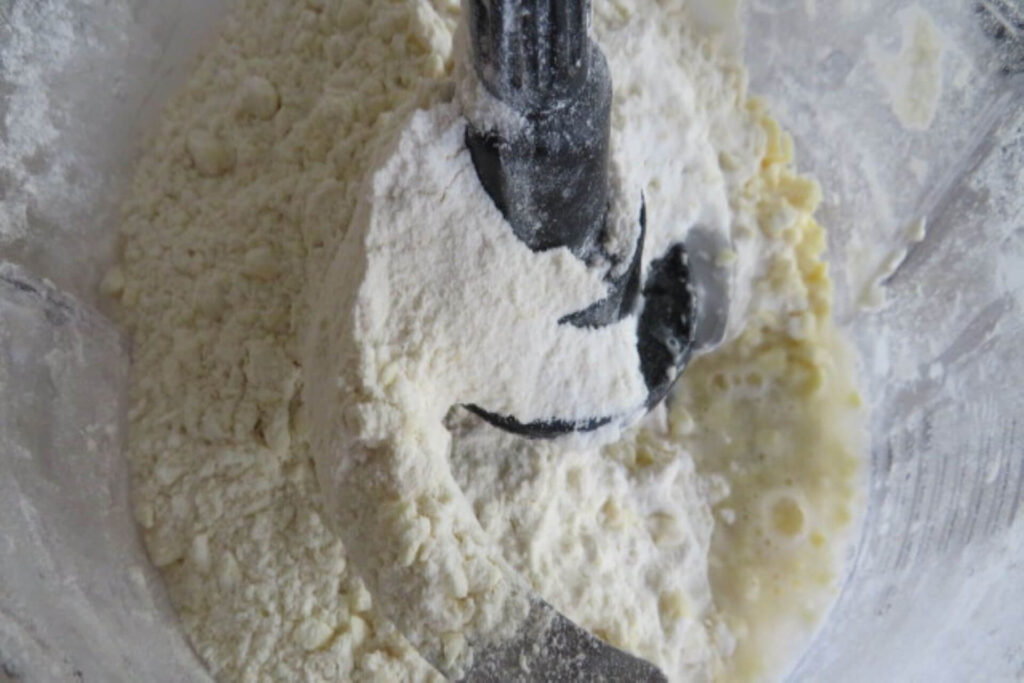
2. How to make the apple filling:
- In the meantime, peel, core and slice the apples using the apple corer. Alternatively, slice the apples 1/4 inch thick.
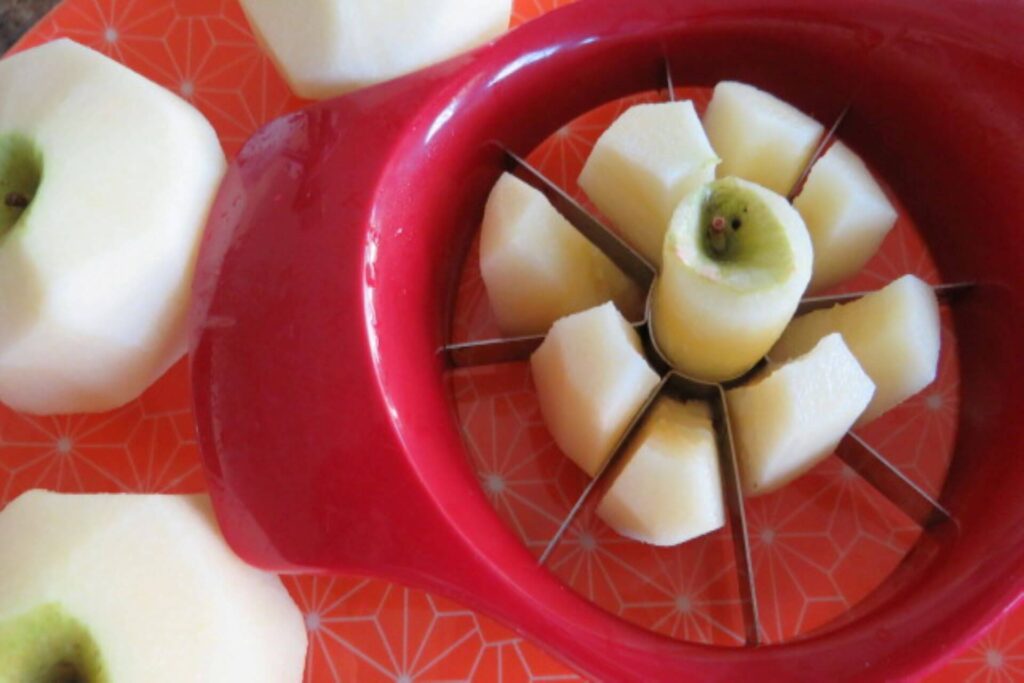
- Heat a saucepan, add the apples, lemon juice, sugar, and butter.
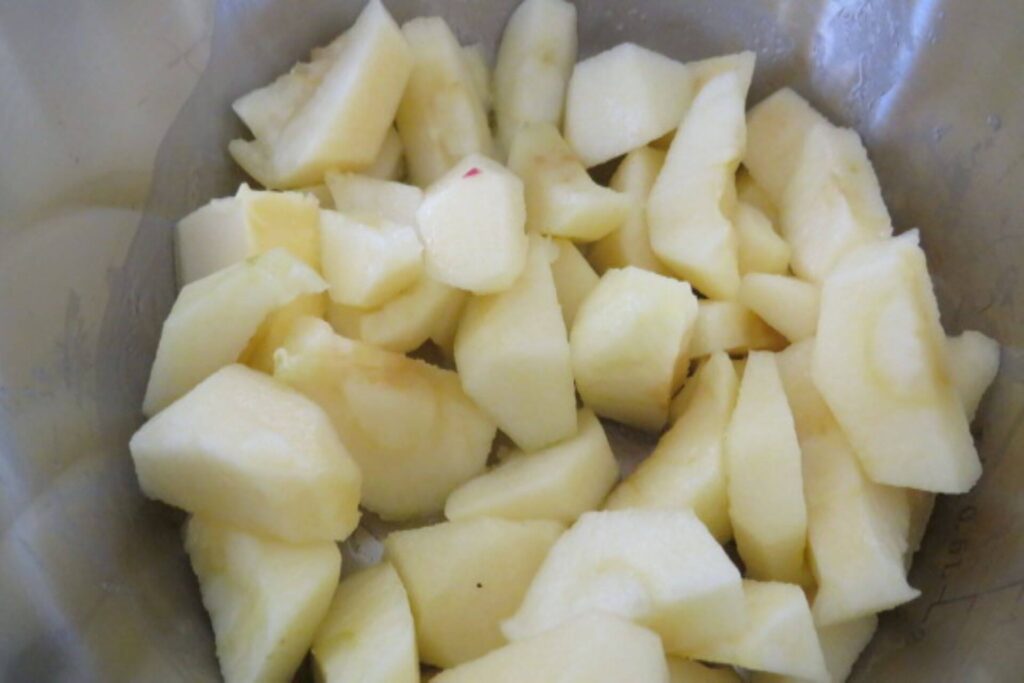
Preheat the oven to 375 degrees F. On medium heat, cook the apples for 10 minutes or until the juices have evaporated leaving moist but not wet or very dry slices. Add the nutmeg and turn off the heat. Allow the apple slices to cool.
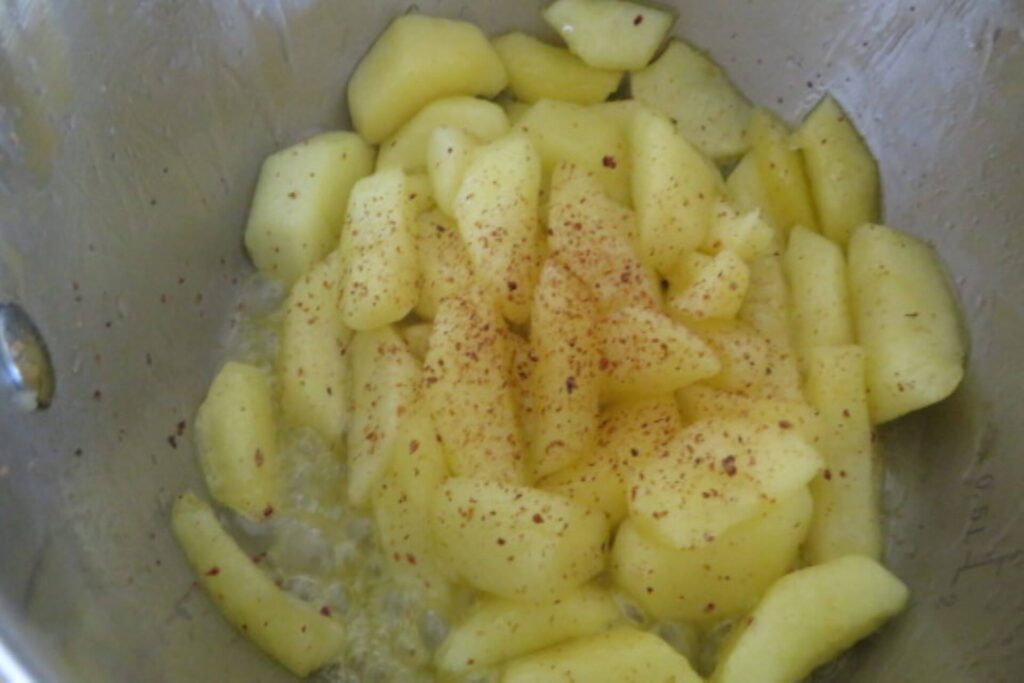
3. How to assemble the Apple Galette:
- Remove the short crust pastry disc and roll out to a 1/6 of an inch thickness to a foot in diameter on a floured surface or board. The edges need not be smooth but can be rugged. This gives it a more rustic look.
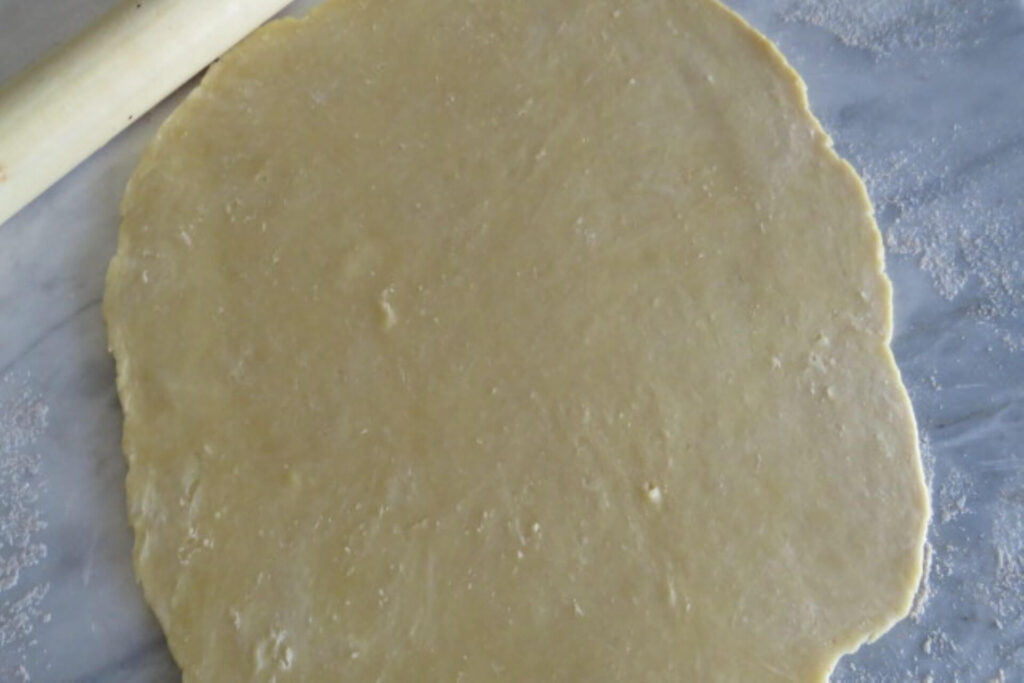
- Place the cooled apple slices in the center of the rolled short crust. Allow 2 inches on the edges for folding.
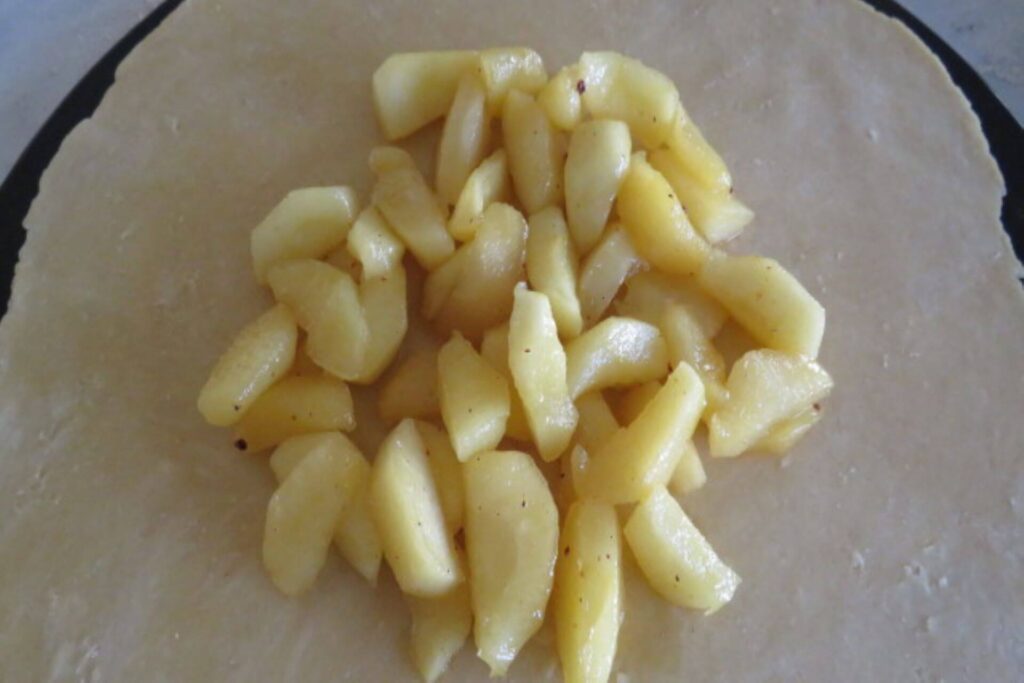
- Take the edges and fold halfway over the apples.
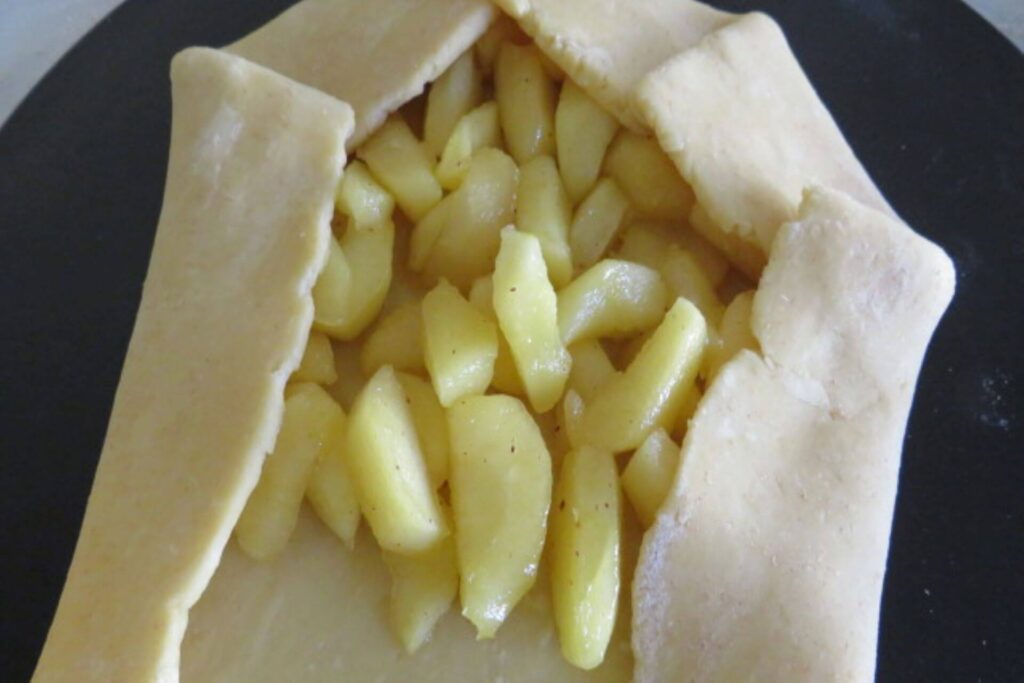
- Fold the edges on all sides. Brush the edges with heavy cream or beaten egg if you prefer.
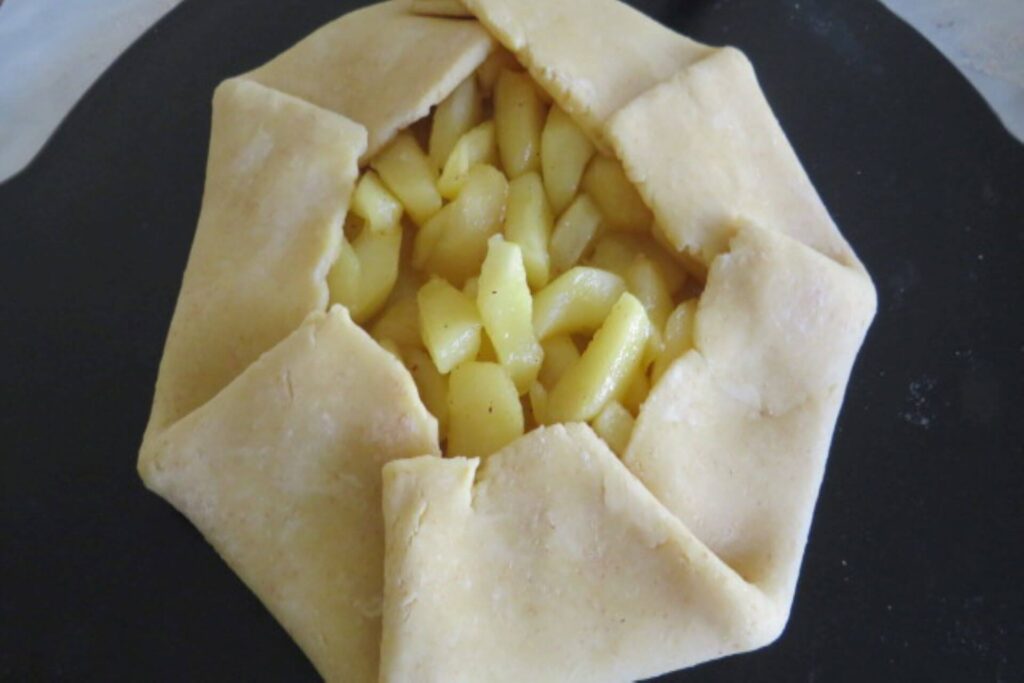
- Bake on a baking sheet or stone tray for 35-40 minutes or until the crust is golden brown. Serve sliced with ice cream or whipped cream.

1. Cooking the apple slices prior to filling the base crust prevents it from becoming soggy. Cooking the apples removes the excess moisture. Other options are to brush the crust with egg white or apricot preserve or dust with some flour before putting the fruit on top.
2. For a savory galette, caramelize some onions and add broccoli florets with cheese and bake.
3. Adding some lemon juice to the apple slices prevents discoloration. Alternatively, you could try soaking the apple slices in with 1/8 tsp of salt in a cup of water.
4. Do not pile a lot of apple slices on the crust. A layer of sliced apples is good enough.
5. Feel free to sprinkle some sugar on the crust or brush with egg wash for a deep golden color or glaze the filling with warmed preserves.
Serving suggestions:
Serve the warm Apple Galette with a scoop of ice cream, frozen yogurt, or whipped cream.
Other French desserts that you would love to try:
Storage:
The short crust pastry or pâte brisée can be frozen for at least three months using a plastic wrap. It can be refrigerated for several days in an airtight container or plastic wrap. If you would like to use the pastry dough from the freezer, defrost it in your refrigerator overnight and then roll and bake. Frozen unbaked Apple Galette (tightly wrapped) can be baked straight from the freezer on a lined baking tray.
Easy Apple Galette
Equipment
- Food processor, saucepan, oven
Ingredients
For the short crust pastry:
- ½ lb all-purpose flour
- 6 oz unsalted butter
- ⅙ tsp salt
- 3 tbsp water ice cold
For the apple filling:
- 1½ lb apple peeled and thick sliced
- 1 tbsp butter unsalted
- 4 tbsp granulated sugar
- 1 tbsp lemon juice
- ¼ tsp nutmeg grated
Instructions
How to make the short crust pastry:
- In a food processor, place the flour, salt and butter cut into cubes.
- Turn on the food processor and give it a quick spin using the dough button for just a few seconds. The butter will be "rubbed" into the flour and will look like bread crumbs.
- Now, add the ice cold water and spin until combined. Empty the contents of the jar on a floured surface and knead into a disc.Refrigerate the disc wrapped in cling film for 15 minutes.
How to make the apple filling:
- In the meantime, peel, core and slice the apples using the apple corer. Alternatively, slice the apples 1/4 inch thick.
- Heat a saucepan, add the apples, lemon juice, sugar, and butter.
- Preheat the oven to 375 degrees F.On medium heat, cook the apples for 10 minutes or until the juices have evaporated leaving moist not wet or dry slices. Add the nutmeg and turn off the heat. Allow the apple slices to cool.
- Remove the short crust pastry disc and roll out to a 1/6 of an inch thickness to a foot in diameter on a floured surface or board. The edges need not be smooth but can be rugged. This gives it a more rustic look.
- Place the cooled apple slices in the center of the rolled short crust. Allow 2 inches on the edges for folding.
- Take the edges and fold halfway over the apples.
- Fold the edges on all sides. Brush the edges with heavy cream or beaten egg if you prefer.
- Bake on a baking sheet or stone tray for 35-40 minutes or until the crust is golden brown. Serve sliced with ice cream or whipped cream.
Notes
- Use ice cold water and cold butter for the dough.
Nutrition


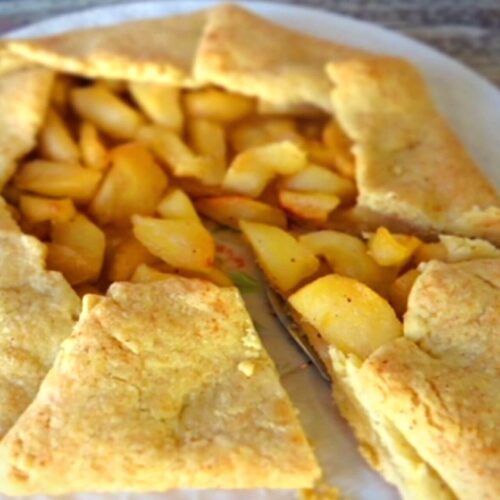
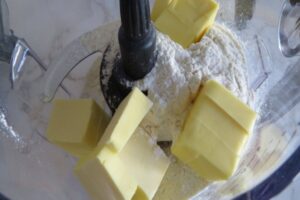
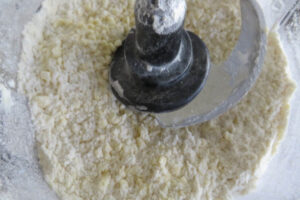
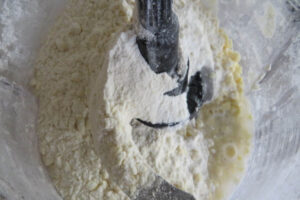
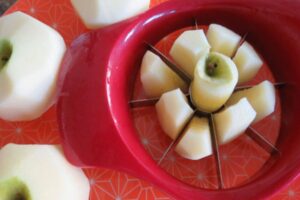
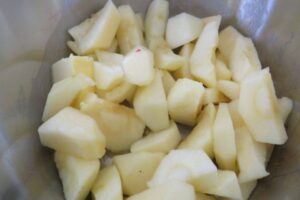
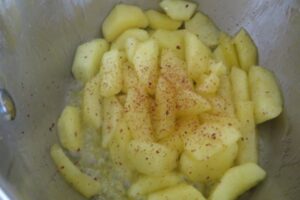
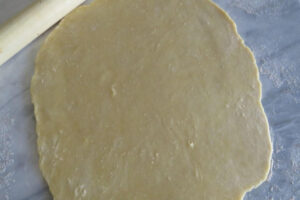
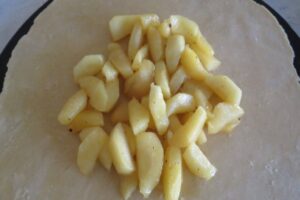
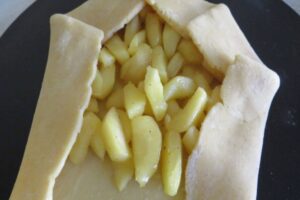
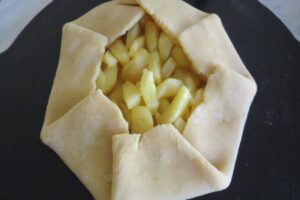





















0 Comments